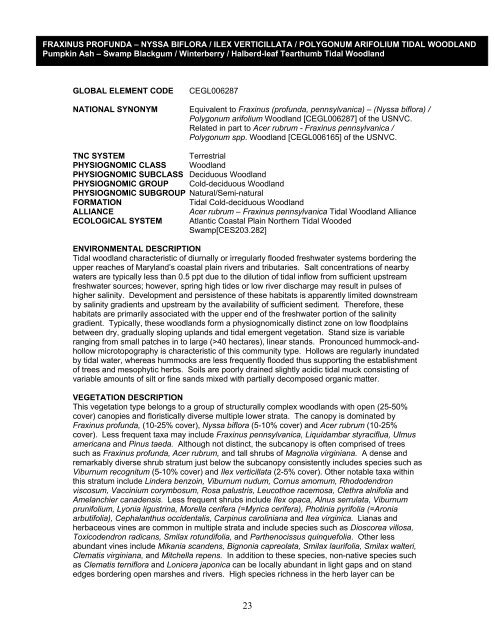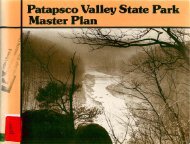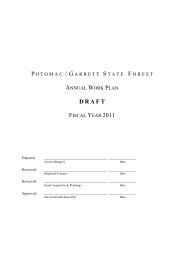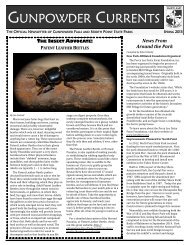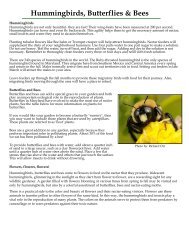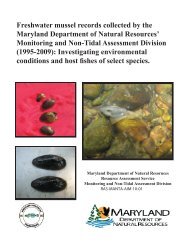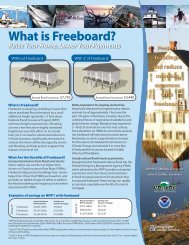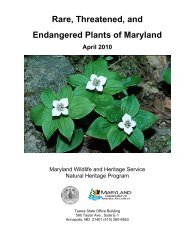tidal hardwood swamps - Maryland Department of Natural Resources
tidal hardwood swamps - Maryland Department of Natural Resources
tidal hardwood swamps - Maryland Department of Natural Resources
You also want an ePaper? Increase the reach of your titles
YUMPU automatically turns print PDFs into web optimized ePapers that Google loves.
FRAXINUS PROFUNDA – NYSSA BIFLORA / ILEX VERTICILLATA / POLYGONUM ARIFOLIUM TIDAL WOODLAND<br />
Pumpkin Ash – Swamp Blackgum / Winterberry / Halberd-leaf Tearthumb Tidal Woodland<br />
GLOBAL ELEMENT CODE CEGL006287<br />
NATIONAL SYNONYM Equivalent to Fraxinus (pr<strong>of</strong>unda, pennsylvanica) – (Nyssa biflora) /<br />
Polygonum arifolium Woodland [CEGL006287] <strong>of</strong> the USNVC.<br />
Related in part to Acer rubrum - Fraxinus pennsylvanica /<br />
Polygonum spp. Woodland [CEGL006165] <strong>of</strong> the USNVC.<br />
TNC SYSTEM Terrestrial<br />
PHYSIOGNOMIC CLASS Woodland<br />
PHYSIOGNOMIC SUBCLASS Deciduous Woodland<br />
PHYSIOGNOMIC GROUP Cold-deciduous Woodland<br />
PHYSIOGNOMIC SUBGROUP <strong>Natural</strong>/Semi-natural<br />
FORMATION Tidal Cold-deciduous Woodland<br />
ALLIANCE Acer rubrum – Fraxinus pennsylvanica Tidal Woodland Alliance<br />
ECOLOGICAL SYSTEM Atlantic Coastal Plain Northern Tidal Wooded<br />
Swamp[CES203.282]<br />
ENVIRONMENTAL DESCRIPTION<br />
Tidal woodland characteristic <strong>of</strong> diurnally or irregularly flooded freshwater systems bordering the<br />
upper reaches <strong>of</strong> <strong>Maryland</strong>’s coastal plain rivers and tributaries. Salt concentrations <strong>of</strong> nearby<br />
waters are typically less than 0.5 ppt due to the dilution <strong>of</strong> <strong>tidal</strong> inflow from sufficient upstream<br />
freshwater sources; however, spring high tides or low river discharge may result in pulses <strong>of</strong><br />
higher salinity. Development and persistence <strong>of</strong> these habitats is apparently limited downstream<br />
by salinity gradients and upstream by the availability <strong>of</strong> sufficient sediment. Therefore, these<br />
habitats are primarily associated with the upper end <strong>of</strong> the freshwater portion <strong>of</strong> the salinity<br />
gradient. Typically, these woodlands form a physiognomically distinct zone on low floodplains<br />
between dry, gradually sloping uplands and <strong>tidal</strong> emergent vegetation. Stand size is variable<br />
ranging from small patches in to large (>40 hectares), linear stands. Pronounced hummock-andhollow<br />
microtopography is characteristic <strong>of</strong> this community type. Hollows are regularly inundated<br />
by <strong>tidal</strong> water, whereas hummocks are less frequently flooded thus supporting the establishment<br />
<strong>of</strong> trees and mesophytic herbs. Soils are poorly drained slightly acidic <strong>tidal</strong> muck consisting <strong>of</strong><br />
variable amounts <strong>of</strong> silt or fine sands mixed with partially decomposed organic matter.<br />
VEGETATION DESCRIPTION<br />
This vegetation type belongs to a group <strong>of</strong> structurally complex woodlands with open (25-50%<br />
cover) canopies and floristically diverse multiple lower strata. The canopy is dominated by<br />
Fraxinus pr<strong>of</strong>unda, (10-25% cover), Nyssa biflora (5-10% cover) and Acer rubrum (10-25%<br />
cover). Less frequent taxa may include Fraxinus pennsylvanica, Liquidambar styraciflua, Ulmus<br />
americana and Pinus taeda. Although not distinct, the subcanopy is <strong>of</strong>ten comprised <strong>of</strong> trees<br />
such as Fraxinus pr<strong>of</strong>unda, Acer rubrum, and tall shrubs <strong>of</strong> Magnolia virginiana. A dense and<br />
remarkably diverse shrub stratum just below the subcanopy consistently includes species such as<br />
Viburnum recognitum (5-10% cover) and Ilex verticillata (2-5% cover). Other notable taxa within<br />
this stratum include Lindera benzoin, Viburnum nudum, Cornus amomum, Rhododendron<br />
viscosum, Vaccinium corymbosum, Rosa palustris, Leucothoe racemosa, Clethra alnifolia and<br />
Amelanchier canadensis. Less frequent shrubs include Ilex opaca, Alnus serrulata, Viburnum<br />
prunifolium, Lyonia ligustrina, Morella cerifera (=Myrica cerifera), Photinia pyrifolia (=Aronia<br />
arbutifolia), Cephalanthus occidentalis, Carpinus caroliniana and Itea virginica. Lianas and<br />
herbaceous vines are common in multiple strata and include species such as Dioscorea villosa,<br />
Toxicodendron radicans, Smilax rotundifolia, and Parthenocissus quinquefolia. Other less<br />
abundant vines include Mikania scandens, Bignonia capreolata, Smilax laurifolia, Smilax walteri,<br />
Clematis virginiana, and Mitchella repens. In addition to these species, non-native species such<br />
as Clematis terniflora and Lonicera japonica can be locally abundant in light gaps and on stand<br />
edges bordering open marshes and rivers. High species richness in the herb layer can be<br />
23


